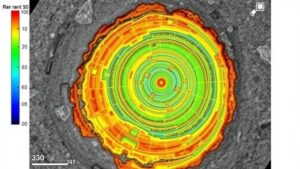Using Gossans as Surface Clues to Deep-Seated Copper Deposits
Using Gossans as Surface Clues to Deep-Seated Copper Deposits
Gossans are an important indicator in mineral exploration, particularly in the search for deep-seated copper deposits. Formed from the oxidation of sulfide minerals, gossans can reveal critical information about the geological conditions and potential resource locations beneath the surface. This article explores the formation, characteristics, and implications of gossans in the context of discerning copper deposits.
Understanding Gossans
Gossans are typically the iron-rich, weathered products of sulfide minerals, most commonly seen as a rusty yellow to brownish coloration on the Earths surface. term “gossan” is derived from the Welsh word gors, meaning to show, indicating their revealing nature in mineral exploration.
These formations often occur in areas with significant hydrothermal activity and can be associated with porphyry copper systems, which are characterized by large mineralized intrusions within the earths crust. Gossans can typically contain the following minerals:
- Oxides of iron, such as goethite and hematite
- Sulfates like jarosite and anglesite
- Other secondary minerals such as malachite and azurite, indicative of copper
Formation and Characteristics of Gossans
The formation of gossans occurs through several geological processes, primarily oxidation, leaching, and hydration of sulfide minerals. The exposure to surface weathering, coupled with the presence of oxygen and carbonic acid, leads to the breakdown of sulfides such as chalcopyrite.
During oxidation, copper is transformed into soluble forms and may migrate downwards, leaving behind a concentration of oxide, carbonate, and sulfate minerals at the surface. key characteristics of gossans include:
- High iron content resulting from the oxidation of sulfide minerals
- Distinct surface textures, often appearing rusty or powdery
- Presence of secondary copper minerals, which can aid in assessing underlying deposits
Gossans as Indicators of Copper Deposits
The presence of gossans can serve as a surface expression of deeper copper deposits, particularly in porphyry copper environments. In regions where gossans are prevalent, exploration geologists focus on the following aspects:
- Geochemical analysis: Sampling of gossanous materials may reveal elevated copper and associated elements such as molybdenum and silver, indicative of deeper mineralization.
- Geological mapping: Identifying gossan structures can help delineate alteration zones associated with copper-bearing intrusions.
- Geophysical surveys: Techniques such as induced polarization (IP) can highlight areas with disseminated sulfides, correlating with gossans at the surface.
Case Studies: Successful Exploration Using Gossans
Several notable mining companies have successfully utilized gossans in their exploration strategies. One prominent example is the Bingham Canyon Mine in Utah, a world-class porphyry copper deposit. Initial gossanous surfaces led geologists to further investigate deeper copper mineralization, resulting in one of the largest copper mines globally.
Another example is found in the Morenci District of Arizona. The identification of extensive gossans in this area was crucial in leading to the discovery of several economically viable copper deposits. Advanced geochemical assays of gossan materials consistently highlighted the location of underlying mineralization, guiding exploration efforts effectively.
Real-World Applications and Future Opportunities
As exploration techniques advance and new technologies become available, the ability to harness gossans for locating copper deposits is becoming increasingly effective. Todays geologists employ methods such as hyperspectral imaging to analyze mineral compositions remotely and identify gossan characteristics without extensive fieldwork.
Also, integrating big data analytics can enhance the interpretation of geochemical samples, refining the exploration process based on historical data trends in gossan formations across various mining districts.
Conclusion
In summary, gossans serve as an essential surface clue to the location of deep-seated copper deposits. By understanding the formation, characteristics, and applications of gossans in exploration, geologists can reduce exploration risk and increase the likelihood of discovering significant mineral resources. As exploration continues to evolve with technological advancements, the reliance on these surface indicators will likely remain a critical component of effective mineral exploration strategies.
Actionable Takeaways
- Use gossans as primary indicators in mineral exploration, particularly in copper-rich regions.
- Conduct thorough geochemical analyses of gossan materials to ascertain potential mineralization beneath the surface.
- Incorporate advanced geophysical and hyperspectral imaging techniques to improve exploration efficiency and accuracy.

